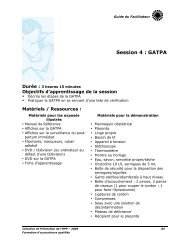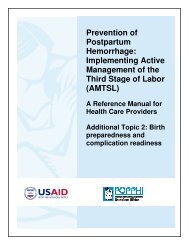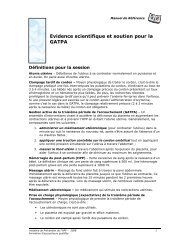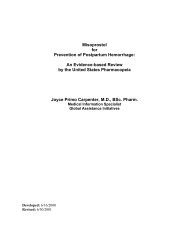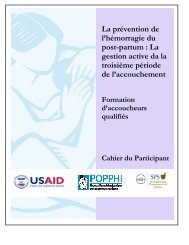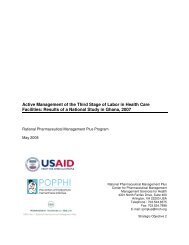English version PDF - POPPHI
English version PDF - POPPHI
English version PDF - POPPHI
Create successful ePaper yourself
Turn your PDF publications into a flip-book with our unique Google optimized e-Paper software.
Card 14Carefully examine the placenta.• Hold the placenta in the palms of the hands, with maternal side facing upwards.• Check whether all of the lobules are present and fit together.• Hold the cord with one hand and allow the placenta and membranes to hang down.• Insert the other hand inside the membranes, with fingers spread out.• Inspect the membranes for completeness.• If membranes or placenta are not complete, take immediate action.• Dispose of the placenta according to national protocols.QUESTIONS1) Why is it important to carefully and completely check the placenta?2) Should you routinely do a manual revision of the uterus to make sure that the uterus is empty?3) How should you dispose of the placenta?KEY MESSAGES• If the placenta is not complete and part of it remains in the uterus:– the uterus cannot contract properly and the woman will continue to bleed.– they can become infected and cause the woman to become very ill or even die.• It is NOT recommended to routinely do a manual revision of the uterus after the placenta has delivered. Some birth attendants like todo a manual revision routinely but this practice is very dangerous and painful and is not necessary UNLESS there are bits of theplacenta left in the uterus. It is much easier and safer to carefully check the placenta to see if there are pieces of the placenta leftinside the uterus.• Every facility has rules and regulations around disposing of the placenta. You should be aware of how you are supposed to dispose ofit. The important thing to remember is that the placenta is potentially very infected and should be handled with great care.



